Table of Contents
If you’re a marketer or leader in a SaaS company, you’ve probably been told that SEO should be one of your biggest growth drivers. And, if your SaaS company is like most, hearing about the power of organic traffic makes it sting that much more when you’re staring at the specter of stagnant organic traffic and paltry lead numbers.
Maybe you’ve tried investing in SEO but haven’t seen the payoff. Or, maybe you’ve tried a “build it and they will come” approach to blog content only to find that no one even noticed.
The truth is that a lot of what’s supposed to work for SaaS SEO either flat out doesn’t or has such a meager return on investment it’s not worth doing. The good news is that there’s an established playbook of things that actually get reliably get results in the form of qualified traffic, leads, and revenue.
In this article, we’ll dissect the specific challenges facing SaaS companies and call out some common misconceptions. We’ll then offer some useful examples of what does work so you can leave feeling more confident in the prospect of SEO working for your SaaS marketing goals.
Three Things SaaS Companies Get Wrong About SEO
We’ve seen many of the same false assumptions, misconceptions, and outdated beliefs surface over and over again in our experience working with SaaS companies.
It’s completely understandable. After all, some of these ideas have permeated the field of SEO for years and unless you’re a full-time search professional, you’re likely to only hear what’s repeated the most. That said, many long-held beliefs and approaches to SEO simply do not get results for modern growth-focused SaaS companies.
Later in this article, we’re going to walk through what frameworks and tactics do work for SaaS SEO. Before we do, though, we’re going to call out what doesn’t.
Here are the top things SaaS companies get wrong about SEO:
Making SEO About Search Outcomes Rather Than Business Outcomes
SEO serves business goals. It sounds obvious when you say it out loud but you’d be surprised how often this simple fact isn’t taken into consideration when creating SaaS SEO strategies. Rather than create a plan and set of strategic activities that directly support a company’s business goals, SaaS companies and the agencies they hire often pursue SEO outcomes as goals in and of themselves.
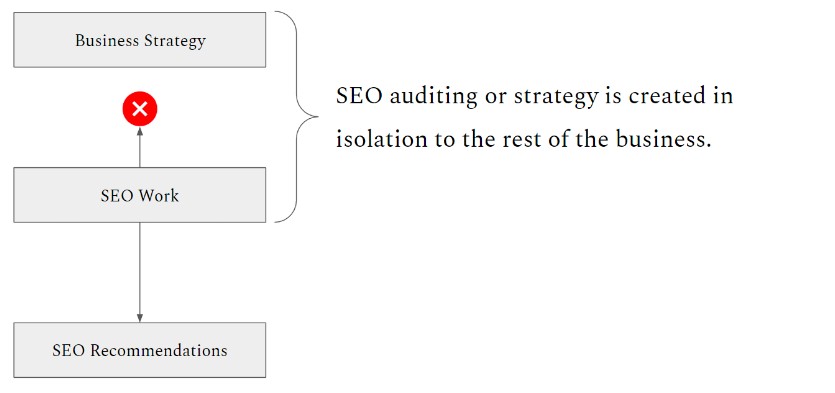
Credit: Adam Gent, The SEO Sprint
Examples of SEO goals:
- Increase organic traffic
- Increase impressions
- Increase keyword rankings
- Achieve various technical optimization benchmarks (like pagespeed metrics)
It’s not that these things aren’t important parts of a successful strategy,it’s that they’re not ends in themselves. Unless they’re tied to business goals, they don’t really achieve anything. An SEO strategy based solely on vanity metrics is a rudderless ship.
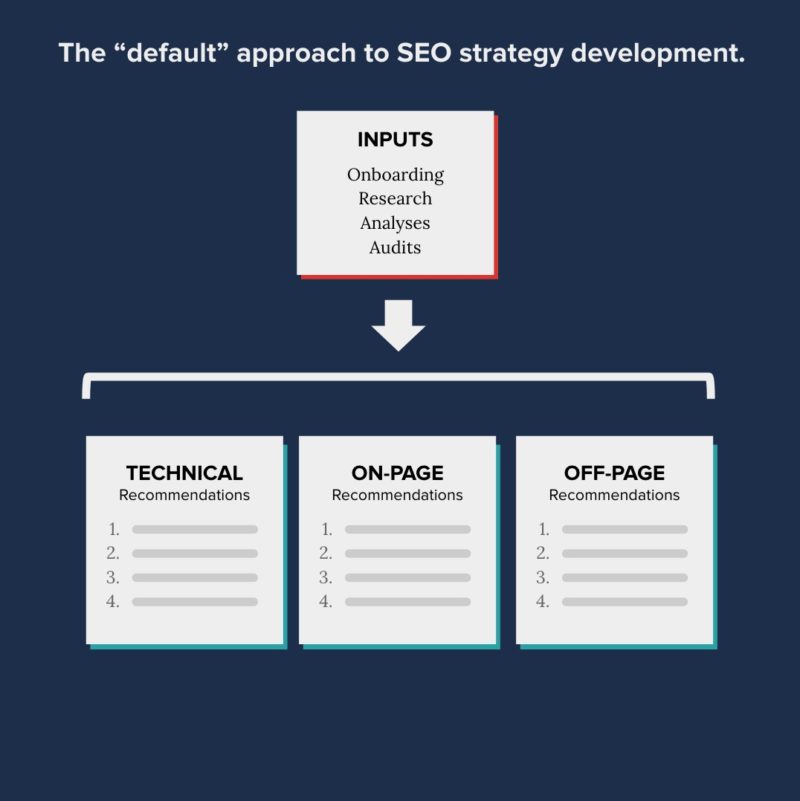
Using a Keyword-First Approach to SEO
Legacy approaches to SEO frame keyword research as the single most important part of the process. They use keyword research tools to find the highest-volume keywords relevant to the product and try to rank for those keywords by “optimizing” landing pages. Here’s why that approach no longer works for most software companies:
It’s often based on false assumptions
First and foremost, starting with keywords begs the question: why are these keywords important to our goals in the first place? The truth is that, oftentimes, they’re not.
Rather than connecting keywords to real business goals, the keyword-first approach assumes certain keywords are important based on their search volume. In our experience, this assumption is often misguided and time is wasted pursuing high-volume, high-competition keywords.
Trying to rank product pages for short-tail keywords is…hard
When users search for short-tail keywords like “cms software” it’s usually because they want to be presented with options. Rather than a homepage or product page, they want an aggregated list of software products they can compare and choose from. This is why the search results for short-tail category keywords are flush with aggregators like G2, Gartner, Software Advice, etc, and why these sites are extremely difficult to outrank. It’s easy to imagine someone searching “cms software,” clicking into G2 from the results, and then opening each of the software product links in a new tab. We’ve all done it.
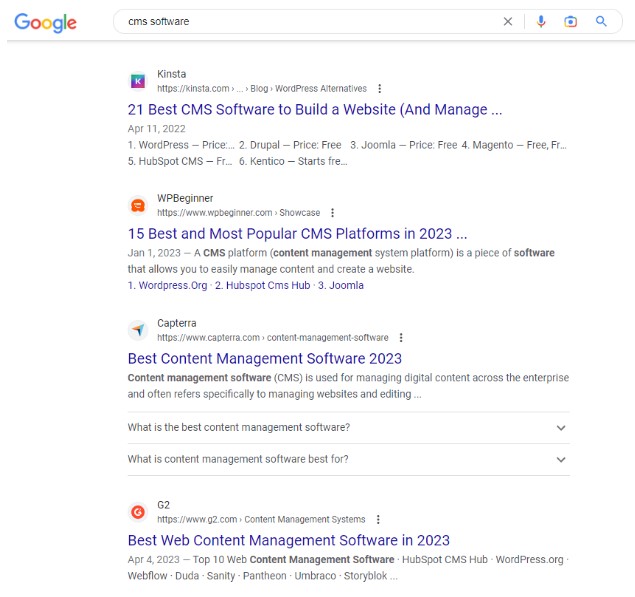
If you do make it your goal to rank primarily for high-volume category keywords, the cost to do so is high compared to less-competitive keywords. It’s important to emphasize at this point that sites do not rank for these keywords simply by making tweaks to their existing pages.
If a brand sees sustained top 10 rankings for very high-volume, short-tail category keywords, it’s usually because they’re true leaders in their vertical. These are massive companies with highly authoritative brands and websites. Their page-one rankings for these keywords can be attributed not only to great SEO but, more importantly, to their status as supersized category leaders.
The quality of traffic and leads is questionable
An often-overlooked downside of pursuing short-tail category keywords is the fact that the quality of traffic and leads that come from searches for these keywords is relatively poor. A decent heuristic here is that the less specific the search, the less likely the searcher is to become a customer. I can hear a CMO or CEO reading this and thinking “I’d way rather rank for the highest-volume, shortest-tail version of our category keyword than not rank for it.” And fair enough. But again, at what cost?
If you’re in a vertical that’s less competitive and you can effectively target the very highest volume and most relevant category keywords in your niche with blog articles, we’re in favor of doing so. But if you feel compelled to rank your homepage for “crm,” (1.9MM annual search volume, 88 difficulty in Ahrefs), you’re probably barking up the wrong tree.
Manual Link Building
If you just felt your cortisol surge because you know for a fact that links still matter(!), I’ll clarify: we’re on the same page. While there’s room for debate around exactly how much links matter (cue the chorus of “it depends”), they’re obviously still important. That said, for SaaS companies with finite time and resources, legacy methods of manual link outreach are - in our opinion - usually not worth pursuing.
Here’s why:
- Oftentimes great content can rank on page one without any backlinks. Maybe not for the most competitive keywords but certainly for a lot of highly relevant, revenue-driving keywords.
- As anyone who’s done it will attest, it’s incredibly time-consuming.
- The ROI is notoriously difficult to track. Some companies won’t mind this. Many data-driven SaaS companies will.
So what to do instead?
We’re aligned with the philosophy of passive link building. The gist of the idea is that you get a better bang for your buck by publishing link-worthy content and dialing in your internal linking than by spending your time sending 100 emails to get 2 responses.
What constitutes link-worthy content is a discussion for another time but the key takeaway is that manual link outreach likely isn’t the best allocation of time and energy for most SaaS companies.
What Does Work for SaaS SEO?
We’ve covered some of the tactics and frameworks that don’t work for SaaS SEO but that’s only half of the equation. In order to make this article useful, we need to spend a little time going through what does work. Below we'll show you what consistently drives results (traffic, leads, and increased MRR) for SaaS companies.
Outcome-Driven Strategies
Rather than starting with “SEO buckets” (technical, on-page, content, etc.), we start with outcomes and force our tactics to serve business goals.
We call this an “outcome-driven strategy” and it’s how we start each of our engagements. During our onboarding conversations, we dig into the specifics of what our client is trying to achieve and seek to understand the situation in its entirety before jumping to conclusions about how search marketing can be useful.
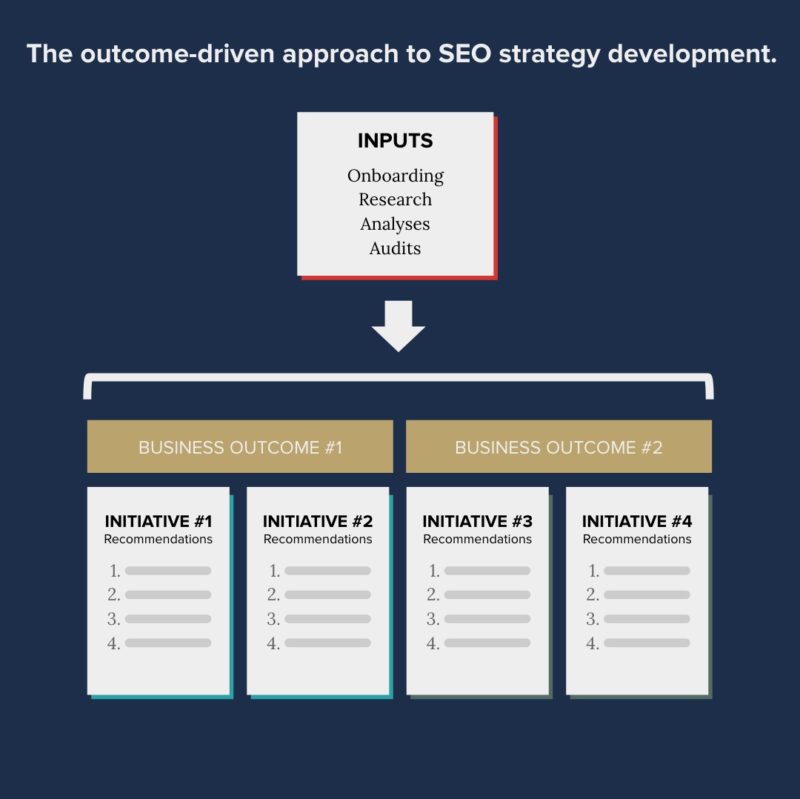
Addressing Customer Pain Points
If you’ve achieved product-market fit, your SaaS product probably addresses a number of customer pain points. The great news is that, even if they haven’t heard of your product or maybe even your category, potential customers are searching for solutions to their problems. This means there’s an orchard full of low-hanging, high-purchase intent keywords that are absolutely ripe for the picking.
Producing content that addresses customer pain points usually means leveraging the Jobs-to-Be-Done framework or something similar. That means thinking and writing about the underlying things potential customers want to achieve rather than focusing on the product itself or complex buyer personas.
Using this approach means you’ll need to have fairly deep knowledge of the product and the ways in which it helps users. If you work for a SaaS company, this may be no problem. However, if you hire an SEO agency and they don’t take the time to learn as much as they can about your product and the problems it solves, that’s a big red flag.
Targeting Use Case Keywords
Earlier on we poo-pooed the idea of “optimizing” your way to getting core landing pages to rank for high-volume category keywords. However, there’s an alternative that stands a much better chance of succeeding: using landing pages to target use case keywords.
Put simply, use case keywords refers to the following format:
{product category keyword} for {industry, type of business, type of use, etc.}
The benefit of targeting these kinds of keywords is that they’re every bit as bottom-of-funnel as broad category keywords but are often less competitive and more targeted toward your niche.
Let’s use our earlier example of “crm” keywords:
- “crm” = 1.9 MM annual search volume, 88 difficulty (Ahrefs)
- “crm for photographers” = 3,000 annual search volume, 15 difficulty (Ahrefs)
You could toil for three lifetimes and likely never crack the top 5 positions for “crm.” Even if you did, a lot of the traffic would be low-quality. If you targeted “crm for photographers,” on the other hand, you could very likely rank in the top 5 positions and the traffic you’d receive would be highly qualified and ready to buy.
Attacking the Bottom of the Funnel with Conversion-Focused Content
This one’s more about sequencing than a specific tactic or approach. While it’s been changing in recent years (especially in the world of SaaS SEO), the dominant approach to blog content sequencing has long been to start with top-of-funnel content and work your way down. By starting with high-volume keywords, the thinking went, you could gain momentum in the form of traffic and increased “brand awareness.”
Over the years working with SaaS clients, we’ve been convinced that this approach is backward. The reason for this is that there are already ample users who are much lower in the funnel by sheer dint of them needing your product. Whether they know they need your product or not, they’re searching using keywords you can target, as we’ve seen in the previous two sections.
When your goal is to drive new business acquisition, it makes sense to dip your net in the pool of customers who are actively looking for your product before starting your long-term brand awareness play. It’s not that TOFU content isn’t important, it’s that the order of operations is wrong.
Making Content Scalable
Coming up with content topics takes effort. Even when there’s plenty of opportunity - and there usually is - it takes a lot of brainpower to fill a content calendar with highly-relevant content topics.
Or does it?
Enter wildcard content. Rather than a type of content itself, “wildcard content” refers to a method of uncovering new content ideas based on predictable patterns. In the wildcard approach, we use templatized keyword patterns to surface new topics by only switching out one variable at a time. The goal is that, by leveraging wildcard content, we can dramatically reduce the amount of time we spend planning content and thereby increase our output.
Here’s an example to illustrate the concept:
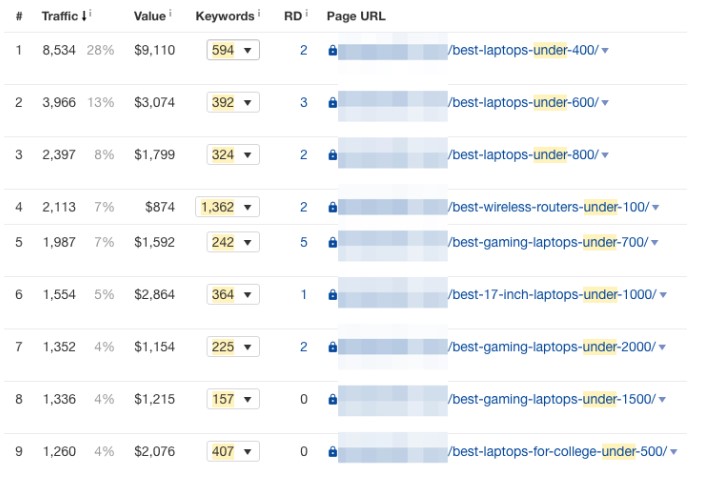
Of course, these variations can be layered to create even more content ideas. In the example above, we can easily envision targeting “best laptops under 1000 for gaming” or “best laptops under 1000 for business.” Of course, the more attributes we layer in, the lower the search volume will be but the purchase intent will be sky-high.
Wildcard content doesn’t just reduce planning time and complexity. It also helps ensure you’re covering a topic comprehensively and promotes a hub-and-spoke approach to publishing and internal linking.
Work with a Trusted Partner to Reach Your SaaS Growth Goals
While SEO can be a powerful tool for SaaS growth, it's important to avoid the common misconceptions that can lead to wasted time and resources. Focusing on search outcomes rather than business outcomes and using a keyword-first approach to SEO are just two examples of mistakes many SaaS companies and their agencies make.
Instead, an SEO strategy should be tied to specific business goals and focus on targeting less competitive, more specific keywords that are relevant to the product and the target audience. Any SaaS SEO agency worth its salt will preach this to you. By following an established playbook of effective SEO strategies, SaaS companies can achieve qualified traffic, leads, and revenue growth.
If you’re interested in growing your SaaS business, drop us a line or learn more about why SaaS companies love working with Uproer.

